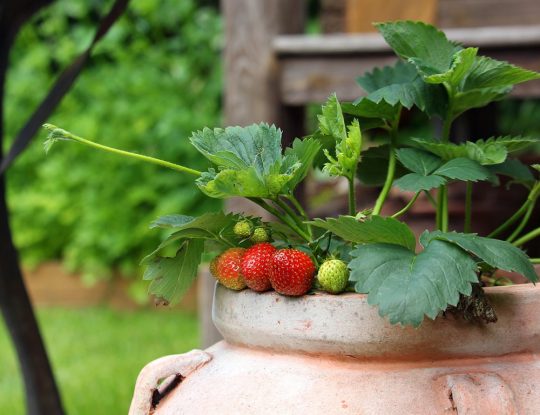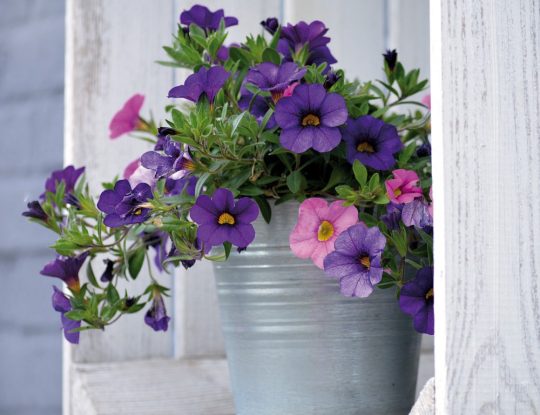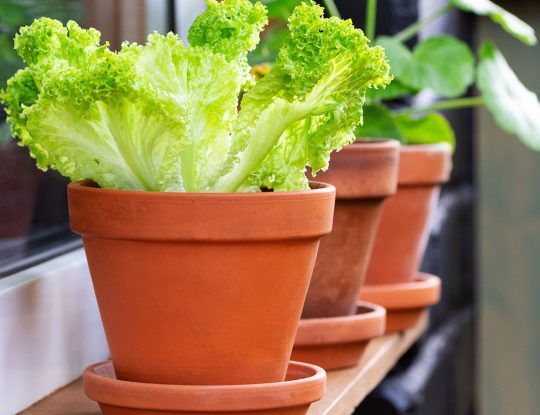by Laurel Aiello
Gardening isn’t just for homeowners with sprawling lawns and immaculate landscaping. Anyone with an apartment balcony or patio can grow flowers and vegetables in various types of containers—all you need is a little bit of space, potting soil, and creativity.

CHOOSING YOUR CONTAINERS
Nearly anything can be turned into a container for planting, from galvanized metal tubs and cement planters to untreated wood boxes, as long as they have holes for drainage. However, each type of container comes with its own pros and cons.
Concrete planters and large glazed pots look sophisticated, but they are also very heavy (especially after you water your plants), so they should only be used if you don’t plan on moving them, or if you place them on a plant caddy with wheels. But they do stand up to the wind,
making them a great choice if you live out east, and they don’t wear down or rot like wooden planter boxes eventually do.

Lightweight options, such as plastic pots, tin planters, and coco-lined baskets, may appear a little less polished, but they are much easier to shuffle around or move inside in the event of a midsummer hail storm. They are also cheaper than glazed pottery, plus many thrift stores have them available secondhand. Just keep them well-watered so they don’t tip over or blow into your neighbor’s yard on a windy day.
Whichever containers you prefer, make sure to choose ones that are big enough to host your
flowers and vegetables all summer long. Plants in small pots will root out quickly and dry up in
no time, demanding water once or twice per day. If they wilt, they can be difficult to revive and
might not produce many flowers and vegetables, so it’s best to provide several inches of soil
space around the roots to retain moisture.

PICKING THE RIGHT PLANTS
Vegetables need more room to grow than you might think, especially if you fertilize them throughout the season (which is highly recommended for optimal fruit production). For example, even determinant tomatoes that don’t exceed a few feet in height still need at least 12 inches of space to grow in their pot. That’s why it’s best to plant one tomato start per pot, or to plant them in a large rectangular container that can house two or three plants beside one another.
Once you’ve picked out the right containers for your patio space, you can begin to decide which plants will go where. Some vegetables need their own pots, like tomatoes, peppers, and potatoes, whereas many annual flowers like some company. To determine how much room to give your plants, always reference the label for their ideal spacing requirements.

Other vegetables that grow well in containers include eggplants, leafy greens, radishes, cucumbers, peas, and potatoes, while larger plants, like melons and zucchini, are typically too big. Some vegetables can share containers depending on their spacing, and if you’re planting seeds for root vegetables that mature at different times (like radishes and carrots), they can be planted among one another. Most herbs do well together in containers, as they tend to have asmaller spread.
It’s also important to consider your vertical space. Vegetables that climb (like beans, peas, and cucumbers) will need some kind of trellis for support, so either stick a trellis inside the pot or lean one up against the side of your house and place the pot next to it. Either way, you’ll want to keep the tallest plants at the back of your container garden so they aren’t shading your low growers.
When designing annual arrangements in containers, many of the same rules apply. Consider the ideal spacing for each plant so you don’t end up with a crowded, root-bound pot by mid-summer, and give sprawling plants like Wave petunias their own space so they don’t dwarf your other flowers.
Also note that while vegetables and herbs need full sun, some annuals will only grow in part sun
or full shade. Plant annuals with similar light requirements—think alocasias, impatiens, and
Creeping Jenny for shade—in the same containers and keep them in their preferred level of
light to avoid wilting or scorched leaves. From there, you can combine all the different heights,
colors, and textures you want to create your own floral aesthetic.

GETTING CREATIVE
The great thing about container gardening is that it affords us the creativity to customize our space. Whether you’re drawn to the wooden farmhouse aesthetic or a contemporary arrangement of metal and concrete, any container can produce a beautiful flower or vegetable garden on your deck or patio. And now is the perfect time to design it, so head to your local nursery or shop around for upcycled items to bring your vision to life when you start planting in May.
Originally published on March 24th, 2023. Updated on April 29th, 2025.
